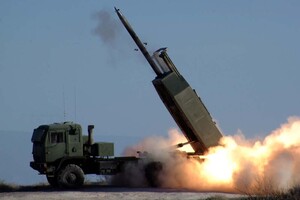Experts point to the fact that the Ukrainian army will receive only a symbolic number of American volley fire systems, and the needs of Kyiv are not just HIMARS.

Transmission of American HIMARS systems
US Army Colonel Benjamin Johnson, US Air Force Colonel Tyson Wetzel and US Marine Corps Colonel John Barranko write about this in an analysis for the Atlantic Council. They note that the Russian campaign in Donbass is deadlocked. Russia has a numerical and fire advantage. But the Ukrainian army is quite effective in deterring its offensive, tactically using intelligence. The military success of each side will depend on the ability to provide troops on the front lines. Russia is sending more and more conscripts to Donbass. And Ukraine will focus on strengthening logistics and deploying more ground systems on the front line. The Kremlin has focused on gathering troops and firepower near the city of Severodonetsk strong>, trying to capture this strategically important city. However, apparently, his offensive slowed down and almost stopped. Limited Ukrainian counterattacks have restored control of some areas of the city. Therefore, according to the authors, the threat of encirclement of Ukrainian troops has decreased. Despite Russia's numerical advantage and better armaments in the region, Ukraine's military has been able to compensate by using intelligence effectively. The authors recall that Ukrainian forces sank the Russian cruiser Moscow and defeated a Russian battalion trying to cross the Seversky Donets River. In addition, the Ukrainian military is launching precise strikes to stop the Russian offensive, deprive the enemy of reinforcements and support, and conduct local counterattacks. The campaign in Donbass is approaching a bloody dead end. Because it takes days or even weeks before there are any changes in the control line in Donbass. The flow of Russian forces and weapons to the region around Severodonetsk is aimed at breaking the Ukrainian resistance, which would allow the Kremlin to surround Ukrainian forces in the region. Russia's offensive
“Because of this, we are convinced that Russia's goal is to destroy most of the Ukrainian forces in the Donbas in order to capture the Donetsk and Luhansk regions completely or at least almost completely. In turn, Ukrainian troops will continue to fire accurately to stop the Russian offensive and deprive the enemy of forces on the front line. In addition, they will continue to conduct limited counterattacks in order to suppress Russian resistance to regain control of the territory and move the line of control closer to the Russian border, “said the US military.
Thus, the ability to provide forces will be critical for both parties. To make up for the losses, the Kremlin may send thousands of conscripts to Ukraine for war. Meanwhile, the Ukrainian army needs to maintain its logistics lines and deploy ground-based fire systems, including long-range artillery, MLRS and unmanned aerial systems, closer to the front line.
US and Allied support
On June 1, the US Department of Defense announced a new $ 700 million military aid package for Ukraine. The highlight of this package was the first batch of American multiple rocket launchers (HIMARS), which the Ukrainian military and government have requested since the beginning of the Russian invasion. The situation in Donbass has made the need for such systems even more acute. The Pentagon has announced the dispatch of four HIMARS systems and ammunition to it. Ukraine will also receive systems capable of hitting targets at a distance of up to 70 kilometers.
How important are HIMARS? As the scale of the war in Ukraine narrowed to the battle for depletion of the Donbas, the ability to use firepower increased the importance of long-range systems. As part of previous US aid packages, 108 155-millimeter artillery howitzers and 220,000 shells were sent to Ukraine. Such howitzers have a range of up to 25 kilometers. Therefore, HIMARS will become the most long-range system of all that the United States has transferred to the Ukrainian army. Each system is capable of launching up to six high-precision guided missiles (GMLRS) or one operational tactical missile (ATACMS). Although the United States has not yet transferred ATACMS to Ukraine.
Read also: NYT: Powerful weapons get to Ukraine faster than knowledge of how to use them
Washington avoids supplying long-range ammunition to HIMARS. Joe Biden's administration has made it clear that it does not intend to supply Ukraine with either ER-GMLRS high-precision missiles (more than 150 kilometers) or ATACMS (300 kilometers) so that Ukrainian forces cannot strike at Russian targets. While this solution reduces the risk of escalation, it also means that four Ukrainian HIMARS systems will have to be deployed 70 kilometers from the Donbass front line or even closer if the Ukrainian army wants to strike at Russian reinforcements or supply lines far from the front. . Because of this, HIMARS systems can become a target for attacks by Russian aircraft or missiles.
Potential future deliveries of HIMARS. The transfer of such systems will expand Ukraine's high-precision fire capabilities. However, too few launchers and the refusal to transmit ER-GMLRS and ATACMS missiles limit the effect of these deliveries. Therefore, according to experts, HIMARS will not affect the situation in Donbass. But it is worth noting that the Biden administration has slowly increased supplies of 155-millimeter howitzers. Initially, the transfer of only 8 long-range artillery systems was announced. Russia reacted with restraint. So it seems that Washington felt more confident and sent another 90 guns. It is possible that the administration is now trying again to assess Russia's response to the transfer of 4 HIMARS systems and GMLRS ammunition before announcing a new package that will include new launchers with ER-GMLRS or ATACMS missiles.
According to experts, HIMARS can play a decisive role in the battle for Donbas, if the number of installations will be significant . And further deliveries of ER-GMLRS missiles will expand Ukraine's ability to strike at long distances along the front line, as well as protect its installations.
The United Kingdom will send MLRS systems. This was announced on April 6 by the Minister of Defense of the Kingdom Ben Wallace. Ukraine will receive three such installations. MLRS is the older and older brother of the American HIMARS system. It can launch up to six missiles at a time. Its tracked chassis gives more maneuverability where passability is difficult. However, the UK system is also slower than HIMARS on a wheelbase.
NATO is still afraid of escalation. The Alliance is still trying to decide what to do next: provide Ukraine with all the necessary equipment to win the war, or simply provide it with enough resources to prolong the war in the hope of Russia's retreat. Ukraine holds its defense longer than anyone expected. And Russian autocrat Vladimir Putin has repeatedly threatened the alliance with escalation if it supplies weapons to Ukraine. However, it is not known what could provoke an escalation on the part of Russia, which would include the use of tactical nuclear weapons. The authors believe that if Russia begins to lose control of its territories en masse, the risk of such an escalation will increase sharply.
Extended range missiles. Putin's threats have already influenced NATO countries' decisions to supply aircraft to Ukraine. They also seem to be delaying the transfer of advanced missile systems. But now, the United States and other NATO countries have taken the risk by agreeing to send HIMARS. The question is whether GMLRS-ER and ATACMS missiles should continue to be phased out, reducing the capabilities of these systems.
Supply of missiles. The Biden administration has announced plans to hand over 48 missiles to HIMARs. This is extremely small, given the threats facing Ukraine. Missile supplies from the United States, Britain and NATO need to be greatly increased to help the Ukrainian army.
The number of missile systems. The announced number of American HIMARS and British MLRS will be mostly symbolic. Ukrainian officials recently explained that 60 such installations would stop the Russian army, 40 would slow its offensive, and 20 would have little effect on the battlefield.
If the battle of Donbass becomes a war of attrition, then Russia has a better chance of winning under the current conditions. It has a larger population, which allows you to make up for losses. In addition, Russia knows that Ukraine depends on old Soviet-made tanks and aircraft. Despite the fact that Poland recently handed over 240 of its T-72 tanks to Ukraine, this is only a temporary solution. To help Ukraine drive Russian forces out of its territory and protect itself in the future, the United States must begin the process of a full transition to American weapons. This means that M1 Abrams tanks, F-16 fighters, light armored personnel carriers and helicopters should be sent to Washington. All these deliveries must take place against the background of the repeated statement of the United States that they will not directly intervene in the conflict.
See the special topic: Two people were killed and 15 were injured in the shelling. The occupiers terrorized the region with artillery and MLRS shelling. Russians have 10-15 times more artillery – intelligence representative Currently, the Armed Forces are already using 155-caliber projectiles according to NATO standards, because there are no others left. Rustamzade: “Tensions cannot be raised in this war. You are at war with a nuclear power. ” According to the expert, we need to find a way to strike thousands of small blows instead of one strong knife. To make the enemy die slowly. Sociologists told how many Ukrainians plan the future of their children in Ukraine, if the threat of war remains Among the residents of eastern Ukraine significantly higher desire to plan the future of children and grandchildren abroad, regardless of developments. Military analyst explains why the West decided to wage war on Russia's depletion According to Agil Rustamzade, the moment of truth will come when we are on par with Russia. In the perspective of one or two months, the West, although dosed, will increase the firepower of the Armed Forces.


